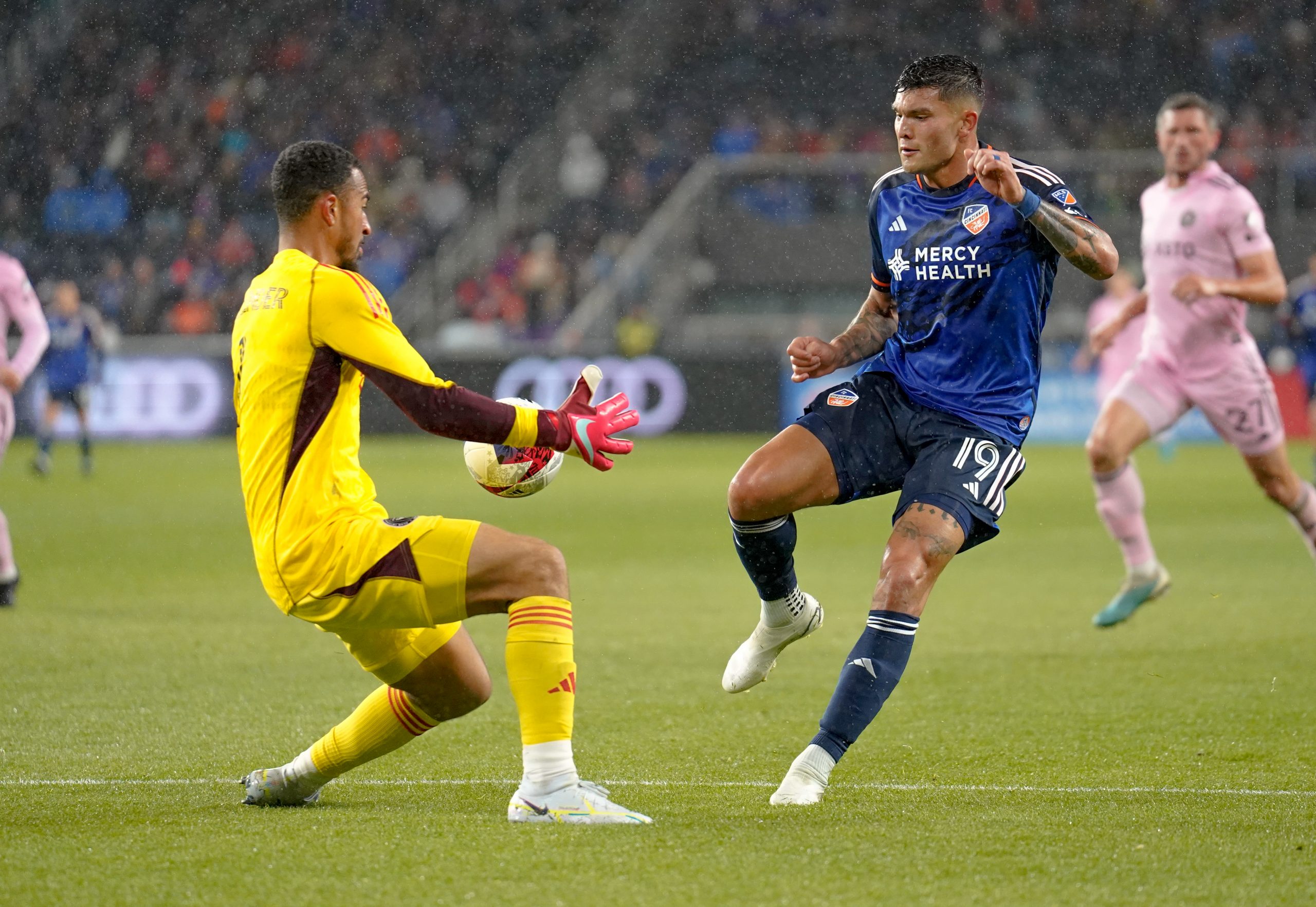For the second week running, the Orange and Blue won an ugly game, keeping a clean sheet in the process. After previous seasons, it might be tough to have any complaints about a 1-0 win. FCC’s defensive unit continued its great start to the season but the offense has yet to truly click. The Orange and Blue’s attack hasn’t been bad, per se, but it certainly hasn’t been as good as many of us hoped. So what’s happening?
Attacking trio woes?
Luciano Acosta, Brenner, and Brandon Vazquez, FCC’s three-headed attacking monster, haven’t had the best start to 2023. From the jump, it’s worth noting that players being a little out-of-sync with each other isn’t an uncommon thing early in the season. Add in the fact that Brenner was away for a chunk of the preseason, and it shouldn’t be a surprise that the attack isn’t firing on all cylinders. It just takes a little bit of time for players to be on the same page, especially as opponents adjust.
But given the highs we saw at the end of last year from FCC’s attacking triumvirate, Brenner, Vazquez, and Acosta, the early season disconnectedness is a little jarring. Through six games in 2023, the three have combined for just two goals. The rest of the team has chipped in, however. FCC has scored eight goals on 8.2 expected goals (xG). So, even though it’s early to be drawing any sweeping conclusions from xG, the Orange and Blue’s attack has been about where we might expect.
For the attack so far this season, there’s good news and not great news. Some of FCC’s most dangerous opportunities in 2023 haven’t resulted in goals. Two hit the post, two were saved and one was blocked. If just two more of those shots find the back of the net, we’re likely having a different conversation about the team’s attacking play.
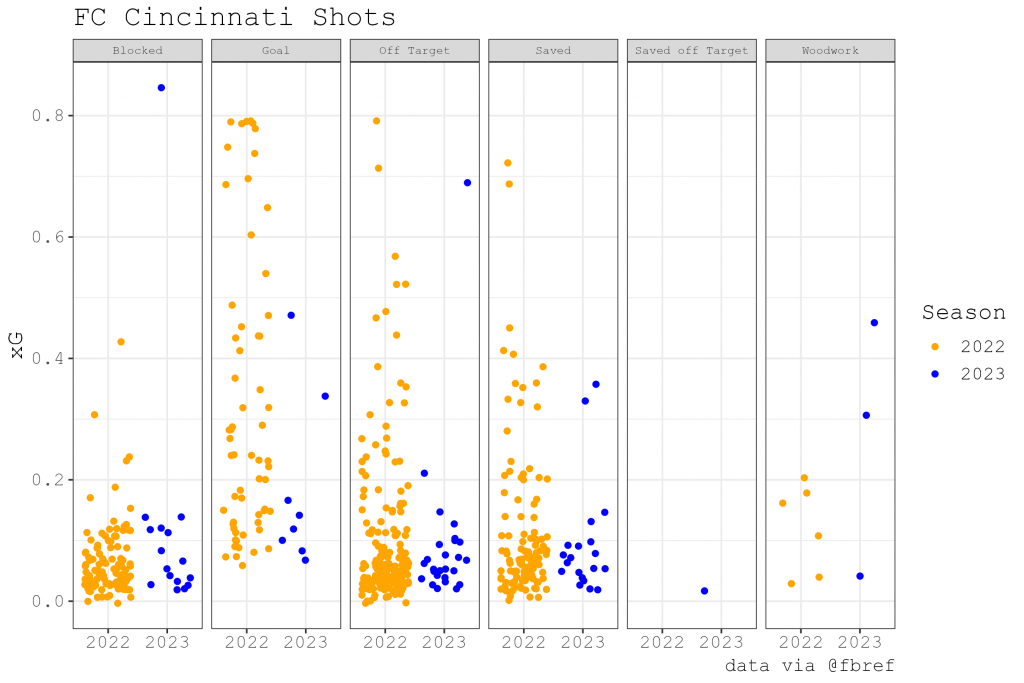
Now for the less good news: the Orange and Blue have largely struggled to create high-quality shots. Really clear-cut chances will always be at a premium in professional soccer but settling for efforts from outside the box is an unreliable way to build an attacking system.
Onto Vazquez, Brenner and Acosta more specifically. I wrote last week that Vazquez’s underlying numbers didn’t concern me and that I thought the goals would come. My thoughts on that haven’t changed. Vazquez has found some big chances this year and, assuming he keeps doing that, the goals will come.

I included Acosta because he’s foundational to what FCC does in the attack, but he’s much more of the provider than the finisher. That’s reflected above in his few high-quality chances but the occasional low-percentage potshot from distance.
Brenner’s start to the season could be a blip or could be a cause for concern. Through 4.7 90s, he’s taken just one shot worth more than 0.12 xG. On Saturday, his three shots were tied for the team-high but all of them came from outside the 18-yard-box.
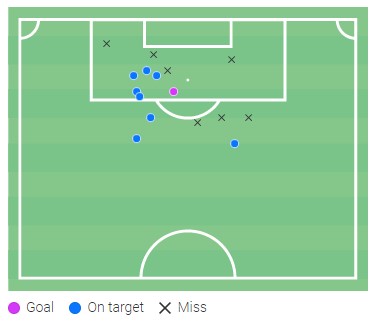
Courtesy of Wyscout
To be fair, one of those shots forced Miami goalkeeper Drake Callender into an acrobatic save but, as noted above, relying on shots from distance isn’t a viable strategy. If FCC can get the ball to Brenner in the box more, this issue should work itself out and the goals will come.
So what has prevented FCC from getting the ball into more advantageous shooting situations in 2023?
A Little Out-Of-Sync
Rewatching the game against Miami, the connection between FCC’s players felt a little bit off. Passes that are normally on target weren’t, and some of those incompletions led to opportunities for the opposition. In the 58th minute against Miami, Brenner received a pass after a turnover and simply passed the ball behind Alvaro Barreal. If the pass was on target, FCC looked to have been off to the races. The margins are small when it comes to one-touch passes made at full speed. Maybe it was just an off-day or the weather had something to do with it or both, but the process seems to be in the right place.
The Orange and Blue generated dangerous opportunities up a goal against Nashville on the counter. The same one-touch, lightning-quick attacks that so often ended in goals last year weren’t finished, however. A couple of scuffed finishes coupled with some quality goalkeeping denied FCC a more comfortable winning margin. As the season continues and players get back into the flow of playing together, we should expect passes to be crisper and the frequency of miscommunication to decrease.
Brenner Dropping Deeper And Acosta Staying Higher
A probably oft-repeated soccer idea I internalized from the Total Soccer Show is that if you see a player doing something once or twice that seems off, they might be doing it of their own accord. But if it keeps happening, over and over again, it’s probably a result of a broader tactical decision from the coach. Such is the case, I believe, with the positioning of Brenner and Acosta this season.
This isn’t necessarily a bad thing, it’s just something I’ve been trying to write about for a few weeks that seems even more relevant now. That positioning has led to some dangerous opportunities, but obviously, there’s a knock-on effect because it can keep Brenner further from goal in some situations where FCC is on the attack.
Brenner has dropped deeper than Acosta in build-up play at times throughout the season. Especially in transition, Noonan has seemingly asked Acosta to play closer to FCC’s striker duo. It can be a little riskier but having Acosta as an outlet up the field on the counter can open up a defense. Also, keeping three players closer to the halfway line hurts opponents’ defense structure, complicating whether or not to push additional players forward.
Here’s an example from the second half of the Nashville game, Brenner dropped deep while Acosta stayed high up the field. Immediately preceding this moment, Barreal passed to Brenner from the left sideline. Brenner did a great job avoiding a couple of Nashville defenders and turn to find Santiago Arias in the middle of the field with room to push forward.
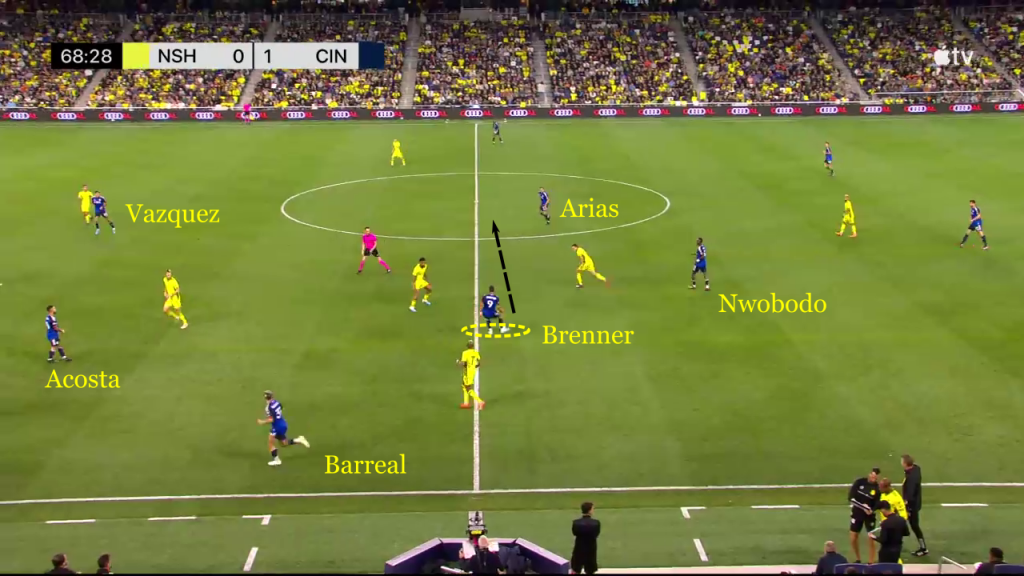
Acosta stayed high on the attacking line with Brandon Vazquez and the two pulled Nashville’s backline towards Joe Willis’ goal, leaving Arias space to drive forward. The sequence ended with Arias’ shot from outside the box being saved by Willis. But because Brenner had started the passage of play in midfield, he never had time to get into a goal-scoring position.
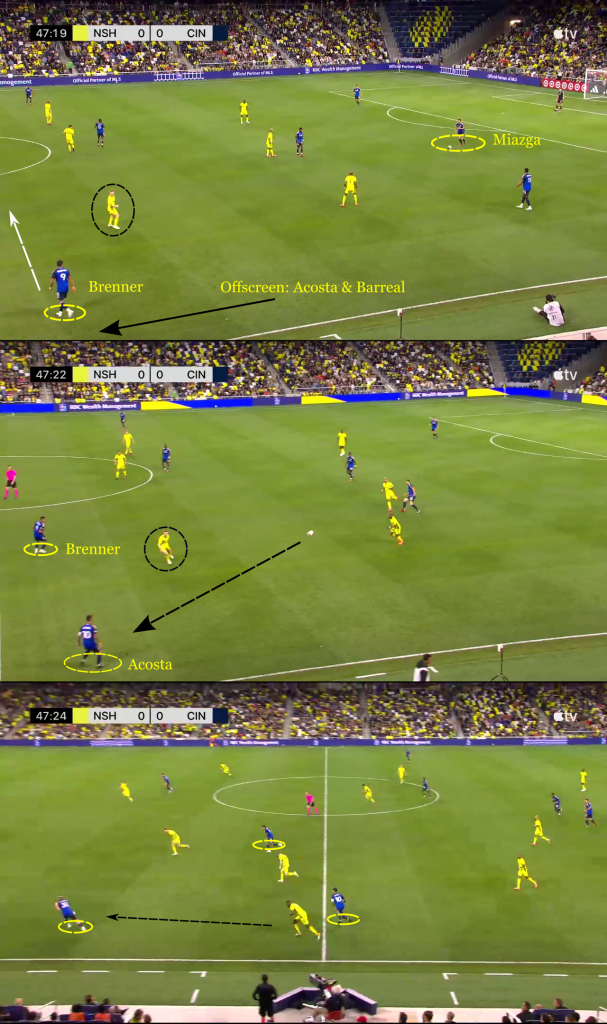
FCC’s goal against Nashville provides an example of how aggressive the team can be with Acosta (and Barreal) pushed high up the field with Brenner operating deeper. The sequence starts with Matt Miazga on the ball and Nashville pushed higher up the field, defending in a narrow 4-3-3. Hany Mukhtar seems to be man-marking Malik Pinto, while Nashville’s other two most forward players ready to press an FCC center back if Miazga decided to play a sideways pass.
Brenner is visible onscreen but Acosta and Barreal are not, as they are pushed high and wide left. Notice Dax McCarty looking over his shoulder, tracking Brenner.
As Miazga carries the ball forward, Brenner makes a run towards the middle of the field, drawing McCarty with him, vacating a passing lane to the left sideline where Acosta has taken up Brenner’s previous position. Mukhtar can’t close Miazga down in time and he plays a perfect line-breaking pass to Acosta’s feet.
Barreal was still pushed high on the left sideline but Nashville’s right back Shaq Moore has to close down Acosta. Acosta one-touches a pass around Moore and Barreal is off to the races. FCC’s aggressive setup put Moore in a bind, either allowing Acosta to dribble at a retreating backline or giving Barreal space to run into, provided that Acosta could complete the pass.
This passage of play ended with Vazquez slamming home the rebound from Barreal’s shot. It’s another situation where Brenner’s participation in build-up play, this time as a decoy, kept him from being the striker in position to finish an attacking sequence. However, his versatility and technical ability allow Noonan to move him around the field like a chess piece to free Acosta of some of his ball progression and build-up duties.
Is Brenner maybe doing too much of that right now? Maybe. It’s a balance that the coaching staff and team will need to find. But Noonan and Co. have found solutions for pretty much every issue they’ve been confronted with so far so I would be confident that they’ll figure this one out too.


